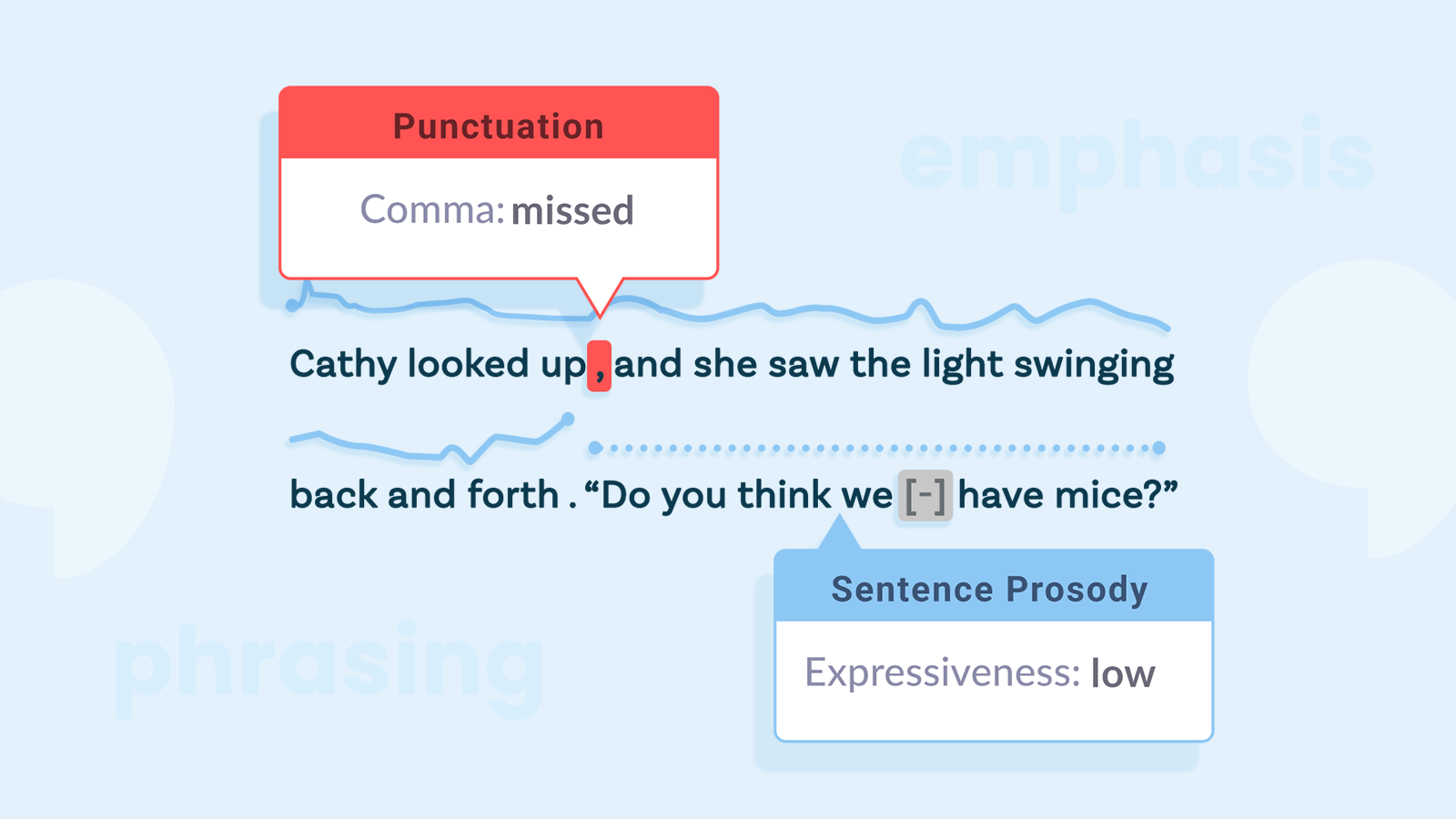13 Q&As on our new Prosody feature
May 4, 2023

SoapBox Fluency, our oral reading fluency (ORF) assessment solution, can now measure children’s prosody — the intonation, rhythm, and pace of their reading.
At our recent Powering Prosody webinar, SoapBox experts demonstrated how our voice engine generates new pitch and phrasing data points for teachers, and the discussion and demo prompted a lot of great audience questions.
Here are 13 of those questions and answers about how our Prosody feature works.
13 Q&As on Prosody
1. How does SoapBox accommodate children’s pitch ranges?
Our Prosody feature returns raw pitch values and can detect any pitch range. Since children’s voices fall within the 215-400 Hz, we’ve tuned our voice engine to be more sensitive in that higher range.
To learn more about how pitch values are computed, clients can dive into our Tech Docs. New to SoapBox? Complete our Get Started form to tell us more about your use case and get access to our Tech Docs.
2. Can I compare the pitch of one child to another?
Prosody returns an array of pitch values (in Hertz) at the word-level for each word in an audio file. Pitch values range from 50 to 600 Hz to capture the typical pitch of adults and children. (The image below is an example JSON of the pitch values returned for a single word.)
You can use this data to compare the pitch of one child to another if it’s relevant for your use case.

3. Does SoapBox have correlations to humans rating prosody using the NAEP rubric?
When developing our Prosody feature, we referenced a number of recognized rubrics, including NAEP, to model how our prosody JSON data can be mapped to a rubric score.
During extensive development and testing, we found a strong correlation between rubric scores generated by our voice engine and human-annotated samples.
4. Can I map SoapBox’s prosody data to my own rubric?
Yes! You can use our prosody data to generate a single rubric score for educators. Clients can dive into our Tech Docs to see detailed guidelines and example calculations of how our JSON data can be mapped to a rubric score.
5. Can SoapBox assist in the interpretation and implementation of prosody data for my product?
Yes! Clients who license SoapBox’s technology have access to SoapBox Studio, where we can work with you to develop the best interpretations and implementations of our prosody data for your product and use case.
6. Can SoapBox’s Prosody feature be used for cross-sentence variation analysis?
Yes! Our voice engine returns raw pitch and phrasing data points, which customers can use for various types of prosody analysis, including cross-sentence variation.
We’re always happy to discuss specific use cases with customers and develop bespoke solutions through SoapBox Studio.

7. How does SoapBox accommodate students with accents?
The SoapBox voice engine is built to understand kids of all accents and dialects. It’s trained on children’s voice data from 193 countries and has been independently validated to show no bias in speech recognition across race, accent, and socioeconomic backgrounds. Learn more about our commitment to equity.
8. Does SoapBox accommodate students with speech disorders?
The SoapBox voice engine can accurately transcribe the speech of children with mild speech disorders. If a person who is unfamiliar with the child can understand their speech, our voice engine will also be able to understand them.
9. Has your Prosody feature been used to determine areas of student need?
Prosody is a brand-new feature designed specifically to measure prosody of read text as part of SoapBox Fluency, our oral reading fluency assessment solution. Our prosody data is currently being used for English language learning (ELL), with both read and spontaneous responses.
10. Does SoapBox’s Prosody feature return volume data?
Our Prosody feature provides detailed data on students’ pitch and pauses, based on extensive research and feedback from our education clients. We are continually working on improving Prosody, and we plan to address volume and stress in the next version of the feature.
11. Is it necessary to send SoapBox the full audio file?
Longer audio files provide more data to accurately assess a child’s prosody. Although it’s possible to use prosody analysis on any length of file, we recommend submitting longer passages to ensure the best possible evaluation of the child’s prosody skills.
12. How does SoapBox protect children’s data privacy?
Fully encrypted and anonymized audio files are sent to our API. No personal identifiable information (PII) is sent to our service, and the recordings are deleted immediately after processing. Our privacy-by-design approach ensures that we cannot identify any individual child from the information sent to our service. Visit our Privacy page to learn more.
13. Where can I learn more about SoapBox’s Prosody feature?
Check out our Prosody webinar and tech blog. SoapBox clients can also try out our new Prosody feature in the SoapBox Fluency demo.
Start using Prosody in your ORF & ELL tools!
Ready to leverage our new prosody feature in your K-12 oral reading assessment and language learning tools? Contact your SoapBox Account Manager today to learn more.
If you’re new to SoapBox, email us at hello@soapboxlabs.com or complete our Get Started form, and we’ll be in touch to discuss your use case.




